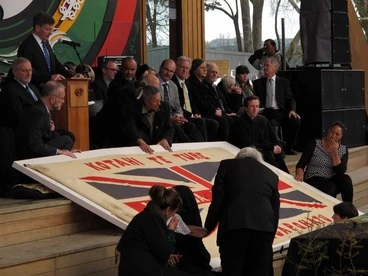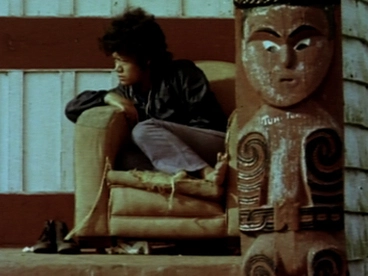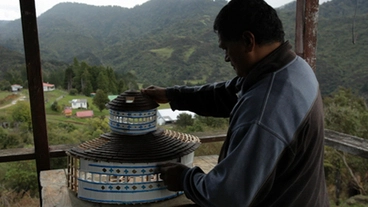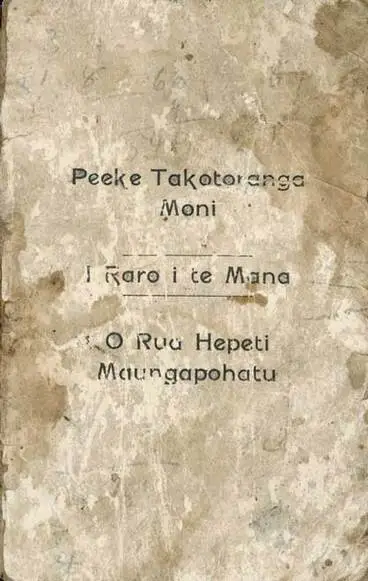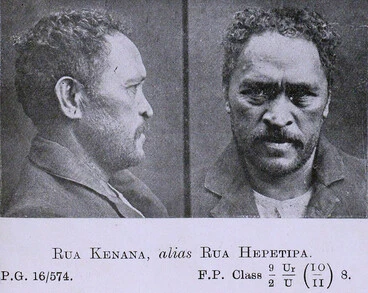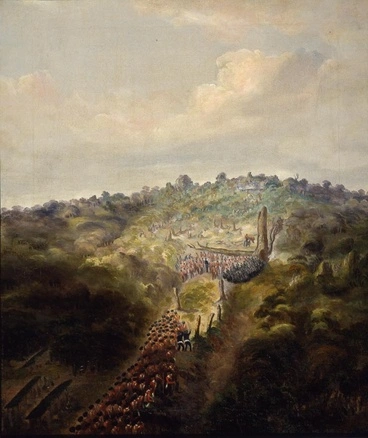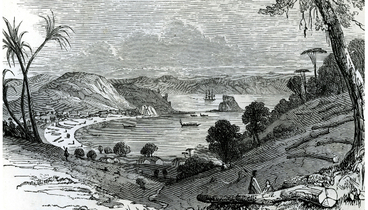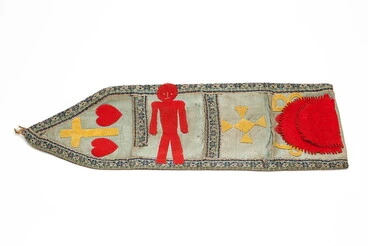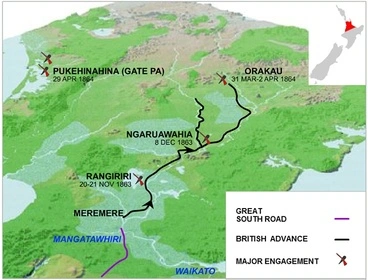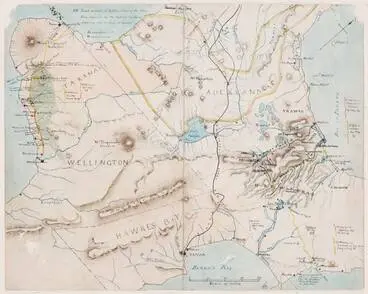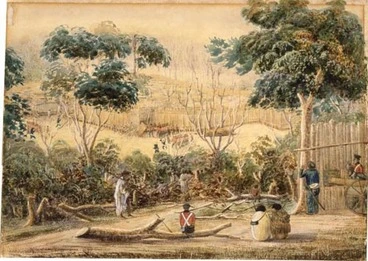The Story of Rua Kēnana, 1916
A DigitalNZ Story by National Library of New Zealand Topics
Rua Kēnana established his religious community at Maungapōhatu in the Urewera Region in 1907, and was arrested there in 1916. The Rua Kēnana Pardon Bill signed into law in 2019 aimed to restore his mana and reputation. SCIS no. 1966471
social_sciences, arts, english, history, health, Māori, technology
Rua Kenana
Alexander Turnbull Library
Rua Kēnana and his family
DigitalNZ
Rua Kenana Hepetipa meeting with Joseph George Ward on the beach at Whakatane
Alexander Turnbull Library
Hear me O south wind no. 2
Museum of New Zealand Te Papa Tongarewa
Huruharama Hou, Maungapohatu
Alexander Turnbull Library
Rua and followers. Maungapohatu.
Auckland War Memorial Museum Tāmaki Paenga Hira
RUA INTERVIEWED. (Poverty Bay Herald, 16 June 1908)
National Library of New Zealand
Children of the Mist
NZ On Screen
Whare Māori - Kāinga/The Village (First Episode)
NZ On Screen
A vision enacted - Rua Kēnana’s lament in law
Radio New Zealand
The Wisdom of the Maori - The New Zealand Railways Magazine, Volume 12, Issue 1 (April 1, 1937)
Victoria University of Wellington
Trial of Rua Kēnana
DigitalNZ
DEATH OF RUA (Evening Post, 25 February 1937)
National Library of New Zealand
RUA'S DOINGS. (Poverty Bay Herald, 29 August 1907)
National Library of New Zealand
Maungapōhatu
DigitalNZ
The arrest of Rua Kēnana
DigitalNZ
Typhoid camp, Maungapōhatu
There was a typhoid outbreak in the winter of 1924 at Maungapōhatu. Sister Annie Henry helped to set up a camp with the Health Department. She was particularly impressed with the way Rua Kēnana went about rebuilding homes and sanitation facilities to help combat the disease. This photo shows Annie (Matekoraha) Miki, her husband Hemi Tawa (with accordion), and her brother Paetawa (centre) at the typhoid camp in Maungapōhatu.
Alexander Turnbull Library
Rua Kēnana and the Reverend John George Laughton
Rua and Presbyterian missionary Laughton stand on the steps of Rua’s new home at Maai which was said to be built from the timbers of the demolished council chamber, Hiona. When Rua returned from prison in 1918, he found the Presbyterian mission has established itself in his community at Maungapōhatu and started a school. Laughton, although not a trained teacher was in charge of the school. Rua finally decided to support the school, on condition that the Presbyterians would not build a church on his land.
Alexander Turnbull Library
The charge against Whata Rua
Whata Rua or Whatu Rua, was arrested along with his father Rua Kēnana in April 1916, when police raided the Ngāi Tūhoe settlement of Maungapōhatu. He was charged with harming two constables with his axe. However, because of contradictions in police evidence, the judge decided there was no case to put before the jury. Whatu was acquitted. It was at this raid that Rua lost his other son Toko, when he was shot by a constable.
National Library of New Zealand
Pinepine Te Rika
Pinepine Te Raka was the first wife of Rua Kēnana Hepetipa. They were married in the 1880s. It is said they had 17 children. In this image (taken around the time Rua was on trial) she holds her grandson Kami Biddle. Pinepine was wahine tapu, the sacred wife who went with Rua to the mountain, where he was shown the diamond by Christ and Te Turuki. She had her own house inside the tapu (sacred) enclosure in Maungapōhatu. Before entering her house, people had to purify themselves with water kept at the doorway, so as not to contaminate her. She was not allowed to enter the kitchens or handle food until very late in life when Rua freed her from tapu.
Alexander Turnbull Library
Hiona – Te Whare Kawana(House of the Governor)
Hiona was a circular building modelled on the ancient Hebrew temple, the Dome of the Rock. The upper chamber was for Rua, his wives and two chiefs. This served as a courthouse which had its entrance via the staircase. The lower hall was the meeting house where Rua’s twelve disciples met the people for hearings and judgements. Hiona was painted white, with diamonds in yellow and clubs in blue. It was built from timber with a split-paling roof. The building deteriorated after 1916 when Rua was imprisoned. It was eventually demolished.
Alexander Turnbull Library
Maungapohatu School, formerly Rua Kēnana's whare kanikani
Initially, Hiona was used for traditional dances. Later around 1914 a separate whare kanikani (circular dance hall) was built near Hiona. It was also used for indoor games by the children of Maungapōhatu. This whare later was turned into a schoolhouse for Rev John George Laughton’s mission school. The whare was probably still a school in 1921 when this photo was taken, because of the muddy slide made by children.
Alexander Turnbull Library
Whakapapa (TMCC6)
Services to Schools
Urewera District Native Reserve Act 1896
Services to Schools
Who are Tūhoe?
Services to Schools
Maungapohatu revisited
Services to Schools
Encircled Lands: Te Urewera, 1820-1921, by Judith Binney
Services to Schools
Pardon for Tūhoe prophet welcomed by Maori Party
Services to Schools
Rua Kēnana
Services to Schools
Māori leaders and heroes
Services to Schools
Story of Rua Kēnana – outlaw of the Urewera
Services to Schools
Portrait of Rua Kēnana
Services to Schools
Rain of the Children
Services to Schools
Tūhoe area of interest is based around Te Urewera
Services to Schools
Rua’s descendants want changes to official pardon
Services to Schools
Cultural interactions in 1800s NZ
Services to Schools
Sister Annie Henry recalls Rua Kēnana
Services to Schools
The mountain of the Lord
Services to Schools
Journeys in National Parks: Te Urewera
Services to Schools
Rua Kēnana and WW1
Services to Schools
What drew Māori to Rua?
Services to Schools
Not much has changed in 96 years: 1916 Rua Kēnana - 2012 Tame Iti
Services to Schools
Rua Kēnana – our Prophet from Te Urewera
Services to Schools
A flag day for Tūhoe
Services to Schools
The last shots fired in the New Zealand Wars
Services to Schools
Maungapohatu and the Maori Millennium
Services to Schools
Rua Kenana Hepetipa, with some of his household and visitors, at Maai, Maungapohatu
Alexander Turnbull Library
War in Tauranga 1864
DigitalNZ
War in the Waikato 1863-65
DigitalNZ
